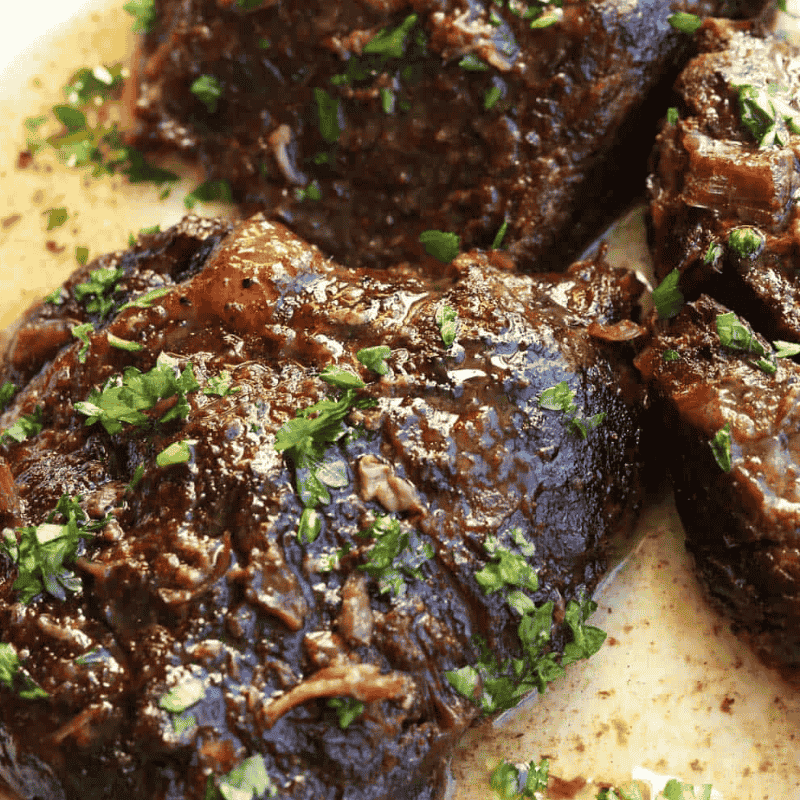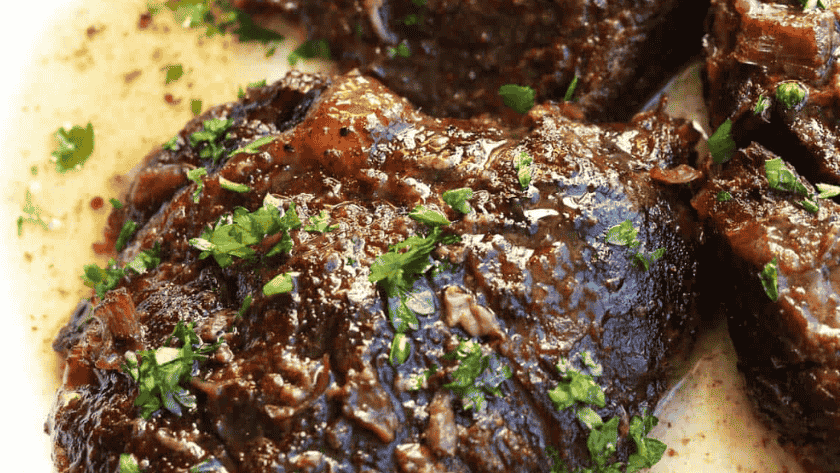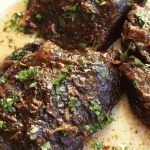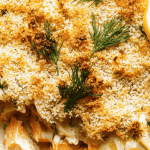The Mary Berry Beef Cheeks recipe is a comforting, slow-cooked dish that transforms an affordable cut of beef into a rich, tender, and flavorful meal. When cooked slowly in red wine and aromatic vegetables, the beef cheeks become melt-in-your-mouth soft, making them perfect for a cozy dinner or a special family gathering. Mary Berry’s take on this classic dish keeps it simple yet sophisticated, ideal for those who love deep flavors without the fuss.
What are Mary Berry Beef Cheeks?
Mary Berry’s Beef Cheeks is a traditional slow-braised beef recipe cooked with red wine, beef stock, onions, garlic, and herbs. The beef cheeks are seared to lock in flavor and then simmered gently for hours until tender. The slow cooking process creates a thick, glossy sauce that pairs perfectly with mashed potatoes or creamy polenta.

Other Popular Mary Berry Recipes
Why This Recipe Is Worth Trying
- Rich and hearty flavor – The slow braising infuses every bite with depth.
- Tender, fall-apart meat – Perfectly cooked cheeks that require minimal effort.
- Perfect for entertaining – Feels elegant but uses simple ingredients.
- Make-ahead friendly – Tastes even better the next day.
- Comfort food at its best – Ideal for cold weather or family dinners.
Essential Ingredients to Make Mary Berry Beef Cheeks
- 1.2kg beef cheeks, trimmed of sinew
- 2 tbsp plain flour
- 2 tbsp olive oil
- 2 onions, finely chopped
- 2 carrots, diced
- 2 celery sticks, sliced
- 3 garlic cloves, minced
- 2 tbsp tomato purée
- 500ml red wine
- 500ml beef stock
- 2 bay leaves
- 1 tsp dried thyme or 2 fresh sprigs
- 1 tbsp Worcestershire sauce
- Salt and black pepper, to taste
- Fresh parsley, chopped (for garnish)
Handy Kitchen Tools for Best Results
- Large ovenproof casserole dish or Dutch oven
- Sharp knife and chopping board
- Wooden spoon for stirring
- Measuring jug
- Tongs for searing
Step-by-Step Guide to Making Mary Berry Beef Cheeks
Step 1: Preheat the Oven
Preheat your oven to 160°C (320°F). A low, consistent temperature is key for tender meat.
Step 2: Season and Brown the Beef Cheeks
Season the beef cheeks with salt and pepper, then dust them lightly with flour. Heat olive oil in a large casserole dish and sear the cheeks in batches until browned on all sides. Remove and set aside.
Step 3: Sauté the Vegetables
In the same pan, add onions, carrots, and celery. Cook over medium heat for 5–6 minutes until softened. Add garlic and cook for another minute.
Step 4: Build the Sauce
Stir in the tomato purée and cook briefly to enhance the flavor. Pour in the red wine and simmer for 3–4 minutes to reduce slightly, scraping the bottom of the pan.
Step 5: Add Stock and Herbs
Return the beef cheeks to the dish. Add beef stock, Worcestershire sauce, thyme, and bay leaves. Stir well to combine and bring to a gentle simmer.
Step 6: Slow Cook to Perfection
Cover with a tight-fitting lid and transfer to the oven. Cook for 2½–3 hours until the beef cheeks are fork-tender and the sauce has thickened beautifully.
Step 7: Final Touch and Serve
Once cooked, remove the bay leaves and adjust the seasoning if needed. Sprinkle chopped parsley before serving. Serve hot with mashed potatoes, roasted vegetables, or crusty bread to soak up the rich sauce.

What I Got Wrong (And How I Fixed It)
- Meat too tough: Didn’t cook long enough; extended time by 30 minutes until tender.
- Sauce watery: Simmered uncovered for 15 minutes to thicken.
- Vegetables too soft: Cut them into larger pieces for texture.
Healthier Version of Mary Berry Beef Cheeks
For a lighter version, use lean beef cuts and replace half the red wine with beef stock. Skim any excess fat from the sauce before serving. Serve with mashed cauliflower instead of potatoes for a lower-carb option.
Ingredient Substitutions for Mary Berry Beef Cheeks
- Beef cheeks: Use beef shin, brisket, or short ribs.
- Red wine: Replace with beef stock and a tablespoon of balsamic vinegar.
- Flour: Use cornstarch or gluten-free flour.
- Worcestershire sauce: Substitute with soy sauce or tamari.
- Thyme: Replace with rosemary or mixed herbs.
Pairing Ideas: What to Serve With Mary Berry Beef Cheeks
- Creamy mashed potatoes – The perfect match for the rich sauce.
- Buttered green beans – Adds freshness and balance.
- Polenta or risotto – Creamy and comforting side options.
- Roasted root vegetables – Sweet and earthy complement to the beef.
- Crusty bread – Ideal for soaking up the flavorful gravy.
Expert Tips for Perfect Mary Berry Beef Cheeks
- Sear properly: Browning locks in flavor and builds the sauce base.
- Cook low and slow: Patience guarantees tender, melt-in-your-mouth beef.
- Deglaze with wine: Scrape the bottom of the pan for maximum flavor.
- Check halfway: Stir occasionally and skim any excess fat.
- Let it rest: Rest the dish for 10 minutes before serving to settle flavors.
- Use good-quality wine: Enhances the richness of the sauce.
- Don’t rush reduction: A glossy sauce develops from slow simmering.
Creative Ways to Customize Mary Berry Beef Cheeks
- Add mushrooms: Boosts umami flavor and texture.
- Include pearl onions: Adds sweetness and visual appeal.
- Add spice: A pinch of smoked paprika for a subtle kick.
- Make it Guinness-braised: Substitute wine for stout for a malty flavor.
- Add herbs: Fresh rosemary or bay leaves intensify the aroma.
- Make it Italian-style: Stir in tomato paste and oregano for a Mediterranean twist.
Storing Mary Berry Beef Cheeks the Right Way
- Cool completely before storing.
- Refrigerate for up to 3 days in an airtight container.
- Freeze for up to 2 months for long-term storage.
- Label and date for freshness tracking.
- Thaw overnight in the refrigerator before reheating.
How to Reheat Beef Cheeks (If Needed)
- Stovetop method: Reheat on low heat, stirring occasionally.
- Oven method: Cover and reheat at 160°C (320°F) for 20–25 minutes.
- Microwave method: Reheat individual portions in short intervals, stirring between each.
Nutritional Breakdown (per serving)
- Calories: 480
- Protein: 42g
- Fat: 25g
- Carbohydrates: 10g
- Fiber: 2g
- Sugar: 4g
- Sodium: 420mg
Mary Berry Beef Cheeks
Mary Berry’s Beef Cheeks is a traditional slow-braised beef recipe cooked with red wine, beef stock, onions, garlic, and herbs. The beef cheeks are seared to lock in flavor and then simmered gently for hours until tender. The slow cooking process creates a thick, glossy sauce that pairs perfectly with mashed potatoes or creamy polenta.
- Prep Time: 20
- Cook Time: 180
- Total Time: 3 hours 20 minutes
- Yield: 4 1x
- Category: Main Course
- Method: Slow braising
- Cuisine: British
Ingredients
-
1.2kg beef cheeks, trimmed of sinew
-
2 tbsp plain flour
-
2 tbsp olive oil
-
2 onions, finely chopped
-
2 carrots, diced
-
2 celery sticks, sliced
-
3 garlic cloves, minced
-
2 tbsp tomato purée
-
500ml red wine
-
500ml beef stock
-
2 bay leaves
-
1 tsp dried thyme or 2 fresh sprigs
-
1 tbsp Worcestershire sauce
-
Salt and black pepper, to taste
-
Fresh parsley, chopped (for garnish)
Instructions
Preheat your oven to 160°C (320°F). A low, consistent temperature is key for tender meat.
Season the beef cheeks with salt and pepper, then dust them lightly with flour. Heat olive oil in a large casserole dish and sear the cheeks in batches until browned on all sides. Remove and set aside.
In the same pan, add onions, carrots, and celery. Cook over medium heat for 5–6 minutes until softened. Add garlic and cook for another minute.
Stir in the tomato purée and cook briefly to enhance the flavor. Pour in the red wine and simmer for 3–4 minutes to reduce slightly, scraping the bottom of the pan.
Return the beef cheeks to the dish. Add beef stock, Worcestershire sauce, thyme, and bay leaves. Stir well to combine and bring to a gentle simmer.
Cover with a tight-fitting lid and transfer to the oven. Cook for 2½–3 hours until the beef cheeks are fork-tender and the sauce has thickened beautifully.
Once cooked, remove the bay leaves and adjust seasoning if needed. Sprinkle chopped parsley before serving. Serve hot with mashed potatoes, roasted vegetables, or crusty bread to soak up the rich sauce.
FAQs
How do I make beef cheeks tender and not tough?
Beef cheeks need long, slow cooking to become tender. Braise them at a low temperature (around 160°C or 320°F) for 2½ to 3 hours. The slow cooking allows the collagen in the meat to break down, resulting in a melt-in-the-mouth texture.
Should I sear beef cheeks before slow cooking?
Yes, always sear beef cheeks before braising. Browning them on all sides adds depth and richness to the sauce by caramelizing the surface of the meat. This step enhances the overall flavor of the dish.
How do I thicken the sauce for beef cheeks?
If the sauce is too thin after cooking, remove the lid for the last 20 minutes to let it reduce naturally. Alternatively, simmer it on the stovetop and stir in a small amount of cornstarch mixed with cold water for a glossy, thicker consistency.
Can I prepare beef cheeks a day in advance?
Absolutely. Beef cheeks taste even better the next day as the flavors deepen. Cook the dish fully, cool it, and refrigerate overnight. When ready to serve, gently reheat it on the stovetop or in the oven until hot throughout.
Wrapping It Up
The Mary Berry Beef Cheeks recipe is a showcase of simple ingredients transformed into a luxurious dish through slow cooking. Rich, hearty, and deeply flavorful, it’s the perfect comfort meal for any season.




